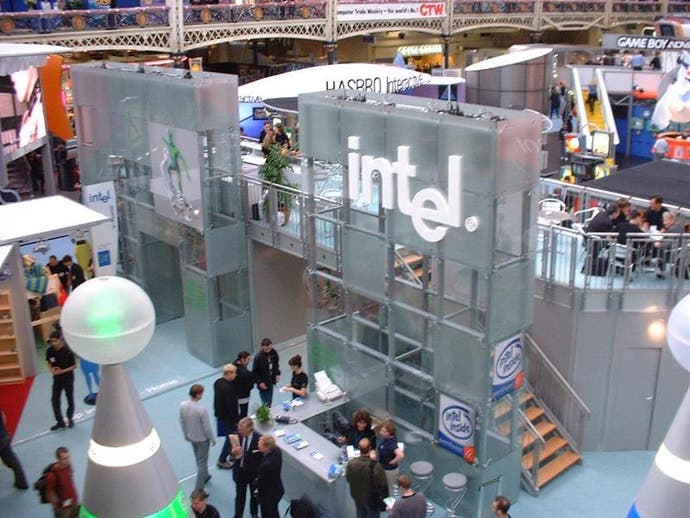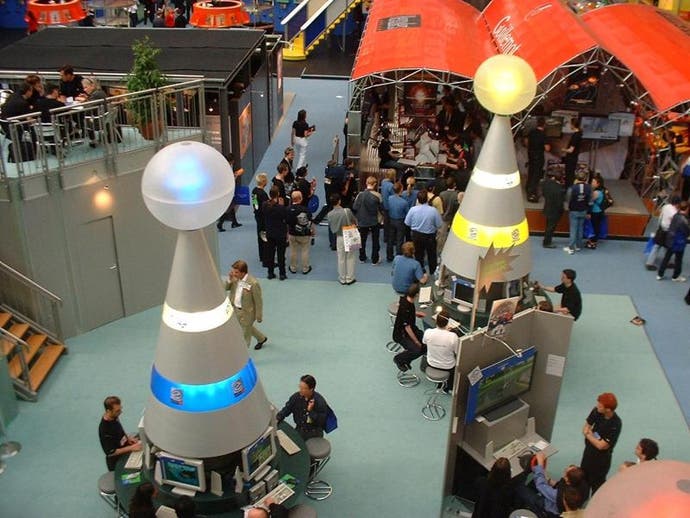Intel Pentium 4
Preview - EuroGamer takes a look at Intel's latest processor family
The ECTS computer games trade show in London was a fairly big showcase for new technology, but in some respects it was also used as a low key platform on which to showcase the latest and greatest in silicon engineering. The Intel stand certainly drew a crowd by showing off Shiny's new strategy game Sacrifice and Microsoft's sequel to the entertaining Midtown Madness, but the big I were also showing off some of their own 'new technology'. The Pentium 4 has to be one of the latest pieces of gossip in the hardware world, and anyone actually getting to see it 'in action' is something of a rarity. Yet with little or no promotion, Intel were quite happily demonstrating software running on their new behemoth CPU at ECTS.

Low Key
The reason for the lack of crowd excitement was probably mainly due to Intel showing off a string of excellent games on their existing Pentium 3, which in itself generated enough interest - Peter Molyneaux's demonstration of 'Black & White' certainly drew a crowd! So what of the Pentium 4? Overlooked by almost everyone, the Intel Pentium 4 occupied a low key 'pod' on the Intel stand, demonstrating unremarkable looking software. Despite the look and feel of the software being shown on this, Intel's newest and possibly greatest CPU, the demos being shown were impressive enough, although more on a technical level than a visual one. One of the titles was an electronic DJ kit that showed off the mixing features of the software while providing a real time display of a virtual dancer moving extremely well with the music. The other major demonstration was based around a virtual world inhabited by 50 or so little creatures. While this may not sound like an impressive demonstration of the raw power of the Pentium 4, I was assured by Intel's Andre Vignaud that each and every event occurring within the world was being randomly generated. These 'random' events included volcanoes erupting with unpredictable consequences and buildings being randomly destroyed, with each resulting piece of debris effecting the environment for the little creatures that inhabited the world. Of course, it goes without saying that the behaviour of each one of the fifty little chappies in this world is uniquely modelled by the P4 processor.

Bus
So what makes the Pentium 4 the greatest thing since sliced bread? Well Intel have realised that memory bandwidth is a key factor in system performance, and that while the move from the 66MHz to 100MHz system bus did provide a much needed boost to system performance, something more was needed. As a result Intel have not just doubled the bus speed, but have applied a 'quad pumped' bus to the Pentium 4. This quad pumped bus is effectively four 100MHz buses running in parallel, to create an effective 400MHz system bus. As a result the 800Mb/sec transfer rate of the current 100MHz front side bus (fsb) is now quadrupled to a maximum of 3.2Gb/sec. This is a truly incredible figure, and one which is not likely to be beaten within the next 12 months. Unfortunately memory technology isn't quite up to this standard yet, or at least not at the consumer level. Intel are quite happily touting RAMBUS as the best memory technology available, but due to the high market price it isn't becoming the high volume memory technology that they had hoped. As a result Intel are being forced to ensure compatibility with older SDRAM technologies. Despite this problem Intel may yet be saved. DDR SDRAM (as seen on newer graphics cards such as the GeForce 2 GTS) will very soon be a mainstream technology for the desktop PC. With DDR SDRAM comes the benefits of doubling the bandwidth with the minimum of problems. Thanks to this the old 800MB/sec can instantly become 1.6GB/Sec. With Intel's dual memory channel support (the ability to run two memory buses synchronously, and therefore double bandwidth), this 1.6Gb/Sec can easily become the 3.2Gb/sec that the P4 can utilise.

Streaming SIMD
Another feature added into the Pentium 4 is SSE2. As I'm sure most of you are aware, Intel introduced the whole idea of 'accelerated function processing' with their MMX microcode extensions, added to the original Pentium core some time after its initial release. While MMX wasn't widely used, and to be honest wasn't extremely useful, for games, it was a leap forward in that CPUs were now able to deal with specific tasks (such as handling multimedia data streams) directly, using specially enhanced instructions as opposed to falling back on their x86 instruction set. AMD followed this example with their own (rather more useful) 3D NOW! instruction set, and Intel responded by creating their own SSE (Streaming SIMD Extensions), used in the Pentium III. These were rather more useful than MMX, complementing the old x86 instruction set, and more programmers started to use the SSE instruction set. Now, in response to further comments by software developers, Intel have created SSE2, which adds yet another 144 instructions which further enhance the current 32-bit x86 instructions. These once again allow for ever faster processing of certain algorithms key to image processing (both 2D and 3D), and routines commonly used in artificial intelligence algorithms.

Conclusion
The Pentium 4 is therefore not only the fastest CPU that Intel have produced (currently running at speeds of 1.4GHz), it is also the most advanced in terms of the potential that it holds. Intel have acknowledged the coming of the GPU (or Graphics Processing Unit), and have realised that the CPU is now something that is related directly towards processing rather than 3D scene generation, as more and more functions are off-loaded on to specialist 3D hardware such as NVIDIA's GeForce graphics cards. Speaking to Andre, it seems that developers are welcoming Intel's new technology with open arms, as it now allows them to develop games which are far more realistic thanks to the increased amount of processing that they can expect to get from CPUs, as well as the new SSE2 instructions. Together this allows them to develop more advanced physics and AI routines - two areas which are usually found lacking in most current games. As gamers we only stand to benefit from these new technologies, if they are priced within the reach of the majority rather than the elite minority of course. And that's the one problem with the Pentium 4 - the current pricing plans will see it out of the reach of all but the most dedicated hardcore gamers when it is first released... Still, you can dream.

.png?width=291&height=164&fit=crop&quality=80&format=jpg&auto=webp)




.jpg?width=291&height=164&fit=crop&quality=80&format=jpg&auto=webp)
